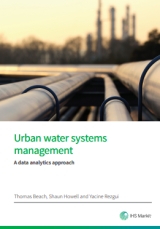Urban water systems management: A data analytics approach EP 105
BRE (Building Research Establishment) is an independent, research-based consultancy, testing and training organisation, operating in the built environment and associated industries.
On 10 April 2018, BRE published Urban water systems management: A data analytics approach (EP 105), by Tom Beach, Shaun Howell and Yacine Rezgui.
The adoption of new information communication technology (ICT) to enable water network operators to intelligently monitor, analyse real-time information, and take appropriate actions, is seen as a key way of reducing the strain on urban water systems.
To this end, the water industry has begun a transformation through the use of smart systems. A big part of this is the increased adoption of sensors analytics software, and decision support tools. However, current smart systems technologies are severely lacking in integration between their different elements. Furthermore, they lack the ability to contextualise the large amount of data collected from urban water systems in a way that promotes scalability, portability and future adaptability.
This 44-page publication proposes an intelligent solution using the Internet of Things, AI, and the semantic web, to achieve an efficient and scaleable use of large scale data in urban water systems.
Its contents are:
- Glossary.
- Executive summary.
- Introduction.
- Background to urban water systems and semantics.
- Data management in urban water systems.
- Using managed data to deliver analytics.
- A methodology for urban water analytic deployment.
- Conclusions.
- References.
[edit] Related articles on Designing Buildings Wiki
- BRE articles on Designing Buildings Wiki.
- BRE Buzz articles on Designing Buildings Wiki.
- BRE Buzz.
- BREEAM Surface water run-off.
- Building Research Establishment.
- Integrated water management.
- Passive water efficiency measures
- Rainwater harvesting.
- Sustainable urban drainage systems.
- Sustainable water.
- Trading systems for water resources.
- Types of water.
- Water.
Featured articles and news
RTPI leader to become new CIOB Chief Executive Officer
Dr Victoria Hills MRTPI, FICE to take over after Caroline Gumble’s departure.
Social and affordable housing, a long term plan for delivery
The “Delivering a Decade of Renewal for Social and Affordable Housing” strategy sets out future path.
A change to adoptive architecture
Effects of global weather warming on architectural detailing, material choice and human interaction.
The proposed publicly owned and backed subsidiary of Homes England, to facilitate new homes.
How big is the problem and what can we do to mitigate the effects?
Overheating guidance and tools for building designers
A number of cool guides to help with the heat.
The UK's Modern Industrial Strategy: A 10 year plan
Previous consultation criticism, current key elements and general support with some persisting reservations.
Building Safety Regulator reforms
New roles, new staff and a new fast track service pave the way for a single construction regulator.
Architectural Technologist CPDs and Communications
CIAT CPD… and how you can do it!
Cooling centres and cool spaces
Managing extreme heat in cities by directing the public to places for heat stress relief and water sources.
Winter gardens: A brief history and warm variations
Extending the season with glass in different forms and terms.
Restoring Great Yarmouth's Winter Gardens
Transforming one of the least sustainable constructions imaginable.
Construction Skills Mission Board launch sector drive
Newly formed government and industry collaboration set strategy for recruiting an additional 100,000 construction workers a year.
New Architects Code comes into effect in September 2025
ARB Architects Code of Conduct and Practice available with ongoing consultation regarding guidance.
Welsh Skills Body (Medr) launches ambitious plan
The new skills body brings together funding and regulation of tertiary education and research for the devolved nation.
Paul Gandy FCIOB announced as next CIOB President
Former Tilbury Douglas CEO takes helm.
UK Infrastructure: A 10 Year Strategy. In brief with reactions
With the National Infrastructure and Service Transformation Authority (NISTA).
























